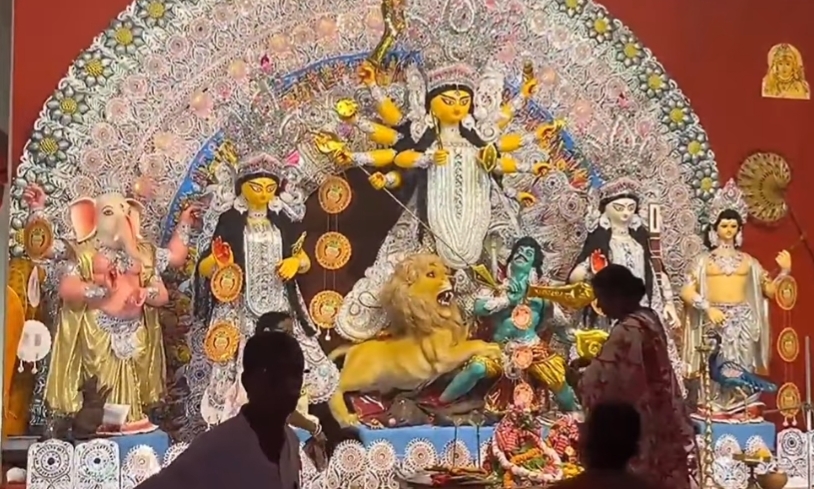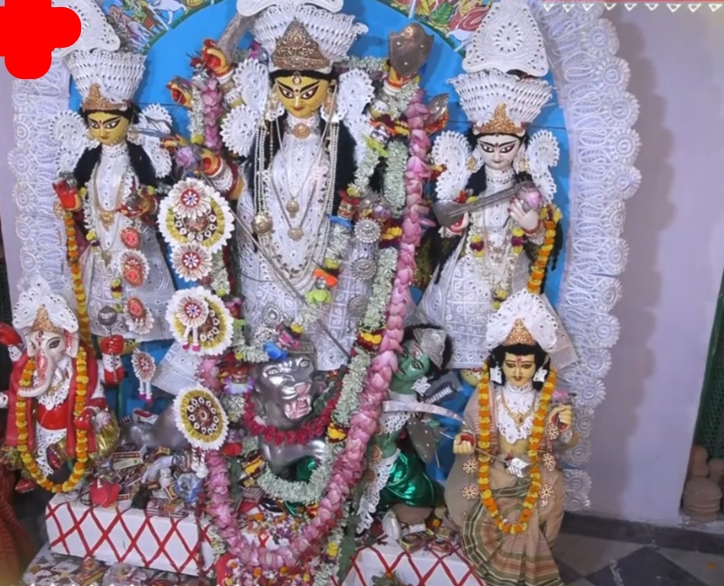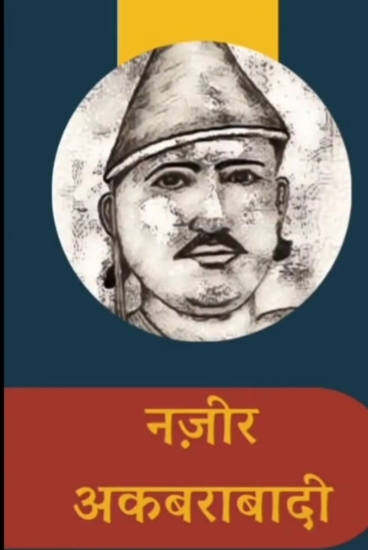
*”Taareef kahoon main kya kya kuchh, ab Durga jee ke darasan kee”*
(*What more can I praise, now of the sight of Durga ji*)
Durga Puja, the grand festival that celebrates Goddess Durga’s victory of good over evil, is not only a ritual of devotion but also a cultural celebration of human unity, joy, and resilience. To describe its aura, the 18th-century poet of the people, Nazeer Akbarabadi, wrote evocatively of the goddess’s grandeur and the liveliness of the festival in his celebrated poem *Durga Ji Ke Darshan*. His verses radiate not only reverence but also highlight the festival’s inclusive spirit, echoing its place as a confluence of devotion, merriment, and communal participation.
Today, Durga Puja remains one of the largest and most defining cultural festivals of India, especially in Bengal but equally resonant across northern and central India, where poets like Nazeer once observed its splendour in the bustling alleys of Kashi.
“Us sundar moorat devee ka, jo baranan ho sab chhaajat hain”
(*That beautiful form of the goddess, whose description overwhelms all*)
The worship of Durga is rooted in the cosmic battle between the goddess and Mahishasura, the buffalo demon who symbolises ego, pride, and oppression. Durga, emerging as a divine force embodying feminine power (*shakti*), represents justice and righteous triumph. Her imagery—ten-armed, riding a lion, carrying weapons bestowed by the gods—stands as one of the most powerful icons in the Indian religious imagination.
During Durga Puja, this imagery is transformed into magnificent idols that adorn decorated pandals across cities and villages. Much like Akbarabadi’s words—where even the moon feels shy before her radiant glow—the modern clay sculptors of Kumartuli and similar artistry hubs carry forward this poetic vision. The goddess’s form, resplendent and awe-inspiring, symbolizes a collective aspiration: the triumph of light over darkness, harmony over chaos.
“Jab kirapa va kee hovat hai, sab va ke darasan paavat hai”
(*When her grace descends, all are blessed with her vision*)
One of the key markers of Durga Puja has always been the sense of grace and inclusivity she bestows. What makes this festival unique is not merely its devotion but the way it transforms neighbourhoods into shared spaces of joy.
Pandals are not restricted to any one community; they are built with contributions pooled by locals, and attended by people of all faiths and backgrounds. This echoes the secular ethos embedded in Akbarabadi’s poem, where the goddess’s blessings reach the wise, the meditative, the devotee, and even the ordinary onlooker. Just as the poet marvels that seekers from “door disa” (distant lands) flock to her presence, Durga Puja today draws vast diasporic communities, where Bengalis and non-Bengalis alike celebrate in New Jersey, London, or Toronto.
This ethos of openness—Durga’s grace falling on all—is what keeps the tradition universal even as its rituals remain profoundly Hindu.
“Jab holee paachhe us jagah, din aakar mangal hota hai”
(*When the days after Holi arrive, that place becomes auspicious*)
Akbarabadi’s imagery of gatherings after Holi, with men and women thronging temples in collective festivity, foreshadows the socio-cultural function of Durga Puja in Bengal and beyond. It is not limited to a season of offerings but has historically functioned as a cultural carnival.
In colonial Bengal, the late 19th century saw *sarbojanin* or community pujas evolve, making festivals sites of social togetherness. This was a time when public expression under British rule found voice in religious congregations. Bal Gangadhar Tilak had used Ganesh Chaturthi in Maharashtra as a public assertion of Indian unity under colonial eyes; Durga Puja, in Bengal, similarly became a stage where nationalist fervour found symbolism in the goddess slaying the demon—an allegory of India’s struggle against imperial domination.
Today, cultural programmes, theatre, storytelling, dance, and musical performances are intrinsic to the puja week, reflecting the continuity of festivals as carriers of shared cultural capital as much as of devotional faith.
“Jo baagh lage hain mandir tak, vah logon se sab bharate hain”
(*The gardens that lead to the temple are filled with people*)
The festival is as much about bazaars, fairs, and festivities as it is about rituals. Akbarabadi’s stanzas describing joyous gatherings—people seated in merriment, lovers strolling amidst gardens, and shops filled with garments shimmering in gold—mirror the very essence of today’s Puja economy.
For Bengal, Durga Puja is not only devotion but a massive cultural and economic driver. According to recent estimates, the festival contributes more than ₹30,000 crore to the state economy, with spending spanning textiles, food, decoration, tourism, and beyond. Durga Puja’s inscription in 2021 on UNESCO’s list of Intangible Cultural Heritage of Humanity also illuminated this dual significance: a religious festival that is simultaneously a massive social and economic phenomenon.
The contrast between sacred devotion within the pandals and the consumerist buzz outside is not contradiction—it is continuity. Festivals, as Akbarabadi observed in the 18th century, have always blended spiritual awe with marketplaces of human joy.
“Har gyaanee va kee saranan hai, har dhyaanee saadhu udhaarin hain”
(*Every scholar is under her refuge, every meditator redeemed by her*)
This verse reflects not only devotion but also the intellectual embeddedness of Durga. The worship of Durga invokes timeless concepts: the feminine divine, the need for moral balance, and the unity of divine and human energies in defeating oppression.
Philosophically tied with Shaktism, the worship of Durga bridges Vedic hymns like the *Devi Sukta* with folk traditions, asserting a continuity of reverence to the maternal divine. The triumph of Durga is not simply mythological but allegorical: she slays the demon within oneself—the forces of greed, domination, and injustice—and reclaims the balance that nourishes the world.
In Bengal, this intellectual framing intertwines with art and literature—from Bankim Chandra Chattopadhyay invoking *Vande Mataram* in the mother goddess’s imagery to modern poets and songwriters shaping her cult not only as divine protector but also as symbol of the nation, of womanhood, and of justice.
“Kuchh dekh bahaare khoovaan kee, saath unake sairen karate hain”
(*Some behold the blossoms of spring, taking leisurely strolls with companions*)
Durga Puja is also a celebration of life’s transience, joy, and renewal. For the younger generation, it becomes a festival of friendships, of romance, of dressing up in new clothes, and of participating in cultural expressions. It is a festival of spring-like rejuvenation, even if celebrated in autumn (*Sharodotsav*).
The moments Akbarabadi describes—people strolling amidst the decorated walkways, watching the blossoms and stalls—find a perfect parallel in the way today’s pandal-hoppers venture across the city all night, viewing one theme-based installation after another, some resembling modern art exhibits, others reviving traditional temple styles.
That creativity—springing like blossoms—makes Durga Puja as much about human imagination as it is about myth.
“Mahaboobon se bhee husnon kee, har aan nigaahen takatee hain”
(*Even the beloveds gaze at beauty upon beauty every moment*)
At its heart, Durga Puja is a festival of beauty—not superficial beauty, but the aesthetics of devotion, art, music, and human creativity. Akbarabadi captured the visual sparkle of fairs—rich garments, shimmering jewels, radiant idols. Today, this dimension has expanded into elaborate artistry that marries innovation with ritual.
Durga Puja pandals have become global stages for art installations, often themed around ecology, gender justice, or folk culture. They are platforms where society reflects on itself while celebrating the goddess. This aesthetic democracy is reminiscent of how Nazeer viewed the goddess—accessible, radiant, and embraced with both reverence and enjoyment.
“Taareef kahoon main kya kya kuchh, ab Durga jee ke darasan kee”
Akbarabadi’s refrain—*what more can I praise, now of the sight of Durga ji*—is the most fitting summary of Durga Puja’s essence. From the goddess’s cosmic triumph to her manifestation in clay idols, from the socio-political role of the puja in India’s past to its global stature today, from devotion to economy to artistry—the festival defies a singular definition.
It is prayer and poetry; it is ritual and revelry. It is the image of the goddess that inspires humility in the scholar and joy in the child. As Akbarabadi, the people’s poet, chronicled centuries ago, Durga Puja is not merely a seasonal festival but a living theatre of India’s diverse spirit—where divinity meets democracy, and where the goddess’s radiant darshan belongs to all.
Hasnain Naqvi is a former member of the history faculty at St. Xavier’s College, Mumbai







